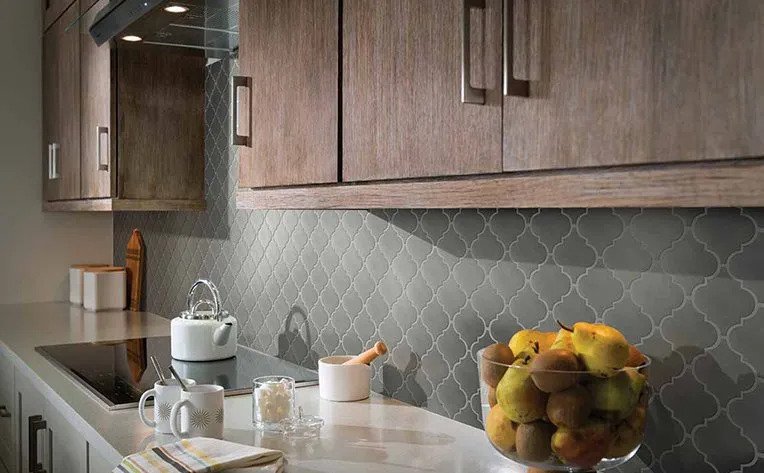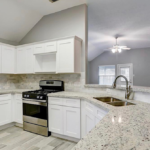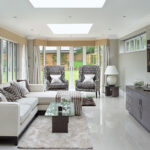It is the little details like a tile backsplash that can make a kitchen. With some careful planning and a creative, exciting design process, you can add a splash of character and claim precious wall space with an eye-catching backsplash that’s as functional as it is fashionable.
What is a Tile Backsplash & Where Should You Put It?
Backsplashes are an expanse of material that typically fills the gaps on a kitchen or bathroom wall between cabinets and a countertop, spanning the length of the countertop. Traditionally, these have ranged from small patches of backsplash that stretch above farmhouse sinks to the pre-2000s mosaic-style backsplashes that were often meant to match kitchen flooring.
Done well, today’s tile backsplashes are a brilliant accent to one of the most trafficked rooms of the household, rounding out the space with interesting textures, colors, and design patterns. Ideally, they can be installed simultaneously with the countertop, but can become a professional or do-it-yourself project at any time.
What are the best tiles to use for a backsplash?
Ceramic, porcelain, cement, stone, marble and even glass are all common styles for today’s backsplashes.
Determining the best tile for a kitchen backsplash is a matter of preference and willingness to experiment. However, there are some things worth knowing in the search for your dream home’s dream tile.
One thing you should understand before installing a backsplash is that not all tiles will cost the same. Tiles are priced by square foot and the cost can vary depending on the type of material. Some materials (like marble) are more expensive than others, but shopping smart and mindfully can give you the look you want at a price that’s comfortable for you. Here are some tips to keep in mind when shopping for a backsplash:
- The look of marble for less: To mimic the look of expensive marble go for a glazed porcelain tile, with high gloss coated over its surface for shine.
- Porcelain and ceramic tiles: These types of tiles have many options to make your kitchen traditional to contemporary. With endless designs and options – you’re sure to find a tile that makes your kitchen unique.
- Stainless steel and natural stone: This material offers a wealth of warmth to your kitchen space. Used together, these materials can create one of a kind looks.
- Mosaic tile: Mosaic tile packs in smaller patterns and seemingly offer more bang for your buck. Depending on the range of materials – this can be an easy way to turn your kitchen space into a work of art.
- Sheet glass: A trend that has been growing in popularity as a great backsplash material for the kitchen is sheet glass. Sheet glass is very low maintenance and incredibly easy to clean, which helps tremendously in an area of the home sure to see its fair share of spills and splashes. Glass can add a lighter look for your space to compliment any style.
- Wood: While this material is not typically used for a traditional backsplash, it can be used to establish a rustic aesthetic, but, as might be expected, make a less functional backsplash without proper care, sealing, and enhancements, and may require some additional research to know what varnish to use for your intended effect.
How much does it cost to install a Backsplash?
How much a backsplash installation costs will depend on square feet used, but bear in mind that kitchens come in all shapes and sizes with awkward angles, making professional installation costs subjective.
In general, marble, ceramic, and porcelain all offer versatility with design, well-suited to evergreen backsplash design styles like subway tiling. Play around with grouts to change the mood of the kitchen when working with these materials, which can offer a dark glow or further enhance the brightness of the backsplash, especially when working with whites.
When selecting the best tile for your backsplash, it’s always worth considering what your design goal is. If you’re looking for a more elaborate design, like a hand-painted Moroccan-style backsplash, you’ll want to weigh heavily what material produces the effect you want and will keep you satisfied for years to come.
Where is the best place for a backsplash?
Home base for most backsplashes will be a kitchen, especially surrounding sinks and stoves. Pragmatically speaking, the backsplash protects the wall from water stains and damage—or, marks from tools and gadgets that live on the counter.
Still, many creative locations make sense to add a backsplash. Tile backsplashes can be added to bathrooms, behind toilets and sinks, and even surrounding showers. Recently there is a trend to install backsplashes on the ceiling to clearly define a shower alcove, and to prevent water damage.
In spaces where you want to try an unconventional approach to shaping a space with tiling, or rein in the effect, try using clearly defined borders. This can create a sort of rail for the eye to follow to contain the tile material and to ensure tiles are placed at an even level in the actual tiling process.
Where exactly should you put backsplash tile in a kitchen, though? In general, tile backsplashes will serve as an approach to coloring in the lines of the kitchen’s busiest area, easing anxieties by being a protective barrier while also “wowing” yourself and others as a statement piece for the room.






